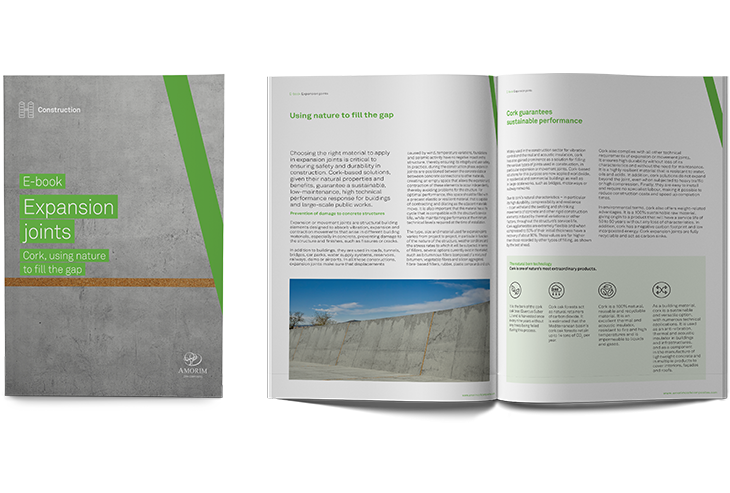Cork: sustainability and technical performance in expansion joints
Cork: sustainability and technical performance in expansion joints
Amorim Cork Composites' cork-based solutions for expansion joints in concrete structures, combine performance, low maintenance and sustainability, and also complies with the construction industry’s stringent quality standards.
Buildings, bridges, highways, dams or airports; there are numerous large-scale concrete structures whose durability and safety depend on correct installation of expansion joints.
Expansion joints are structural building elements that are positioned between concrete slabs or between concrete connections to other materials. They are designed to absorb vibration, expansion and contraction movements that occur in different construction materials, which can cause serious damage - such as fissures or cracks.
The objective is to create an empty space between the various elements of the structure so that, whenever they contract or dilate, due to weather conditions or thermal variations, these movements do not cause structural damage. To ensure optimal performance, the gaps between the elements should be filled with a pre-formed elastic or resilient material whose life cycle is compatible with the structure’s working life, while maintaining performance at the technical levels required at the time of installation.
Cork is an excellent filler solution for expansion joints and are currently being used in commercial and residential buildings, as well as, in large public works facilities around the world.
Five reasons to use cork in expansion joints
-
Cork joints naturally supports the movement of concrete structures without causing deterioration, due to cork’s high compressibility, recovery capacity and resilience.
-
Cork expansion joints have an average lifetime of 50 - 60 years without loss of characteristics thus assuring a perfect structure performance level.
-
Cork-filled expansion joints do not expand beyond the joint, even when subjected to heavy traffic or high compression.
-
Cork expansion joints are easy to install, require no specialized workers and will save time and labor costs.
-
Cork is a 100% sustainable raw material with a negative carbon footprint and low incorporated energy. Cork expansion joints are fully recyclable and act as carbon sinks.
Amorim Cork Composites offers a wide range of solutions for the expansion joint market, sold under the Expandacork brand. All Expandacork products comply with ASTM 1752 and ASTM D 545 standards.
Compared to other options available on the market such as Bituminous fiber boards or asphalt-based fillers, Cork exceeds in terms of recovery and long-term performance.
In a demanding and fast-growing market, Middle Eastern countries have been embracing these solutions, and there are many iconic construction projects which already incorporate them.
This includes major works in Doha, in Qatar, such as the headquarters of the Qatar Foundation, the green line of the Doha metro network, the second phase of the orbital highway around the city or the motorway that connects Doha to the city of Lusail. Besides these references, we can also mention Bangkok airport, several roads in Malasya and multiple projects across North America.
Specifying the material to be applied as a filler in expansion joints plays a key role in ensuring the safety and durability of buildings and public works. Cork-based solutions, given their natural properties and benefits, guarantee a sustainable, low-maintenance, high technical performance response for buildings and large-scale projects where premium quality, safety and durability are key.

